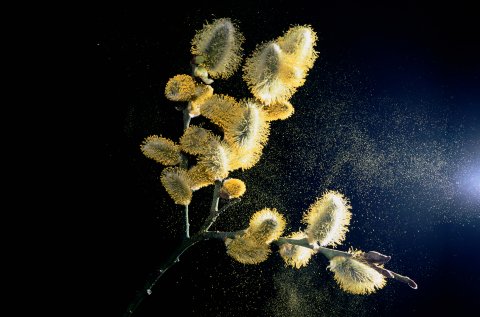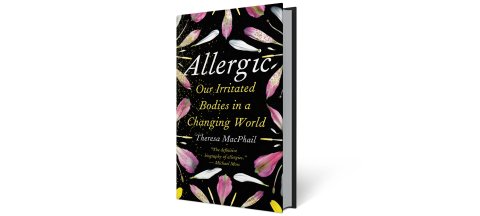Achoo! This spring, seasonal allergy symptoms are as bad as they've ever been for many people...or worse. Tissues, antihistamines, nose sprays, inhalers and eye drops are constant companions for the growing number of people who suffer from allergies. Around 40 percent of all people have at least one allergic condition today, and unfortunately, the outlook for the future isn't much brighter. But why? Acclaimed medical anthropologist Theresa MacPhail investigates the history of allergies and traces the causes of their increasing prevalence in her book, Allergic: Our Irritated Bodies in a Changing World (Random House). She explains why there's an uptick in all allergic conditions—food allergies, asthma, eczema, environmental allergies and more—and what we can do about it. In this excerpt from her book, MacPhail focuses on why climate change is a leading cause of your increased hay fever symptoms.

If you've felt as though your eyes were itchier, your nose was stuffier, or your sneezing fits have been getting worse over the past few years, you're probably correct. The reason likely has something to do with changes to the average pollen load (the amount of pollen in the air), the air quality itself (whether on average it is good, fair or poor) and the indirect effects of climate change on everything from the number of mold spores to crop production to trapped heat to the circulation of air.
Scientific researchers have amassed evidence showing that recent environmental changes are both overwhelming and confusing to our immune systems, helping to drive the increase in the global rate of all allergic conditions throughout the last century. They've found that the changes to the air we breathe correlate with an increased risk of developing allergic disease.
Perhaps some of the strongest evidence in support of the idea that our environments are to a certain extent causing the increase in all our allergies comes from studying our white blood cells themselves.
New research (2020) from the Wellcome Sanger Institute, a leading nonprofit research institute in the United Kingdom, shows that the more our T cells have reacted to an antigen (say, dust mites) in the past, the faster they react in the present.
Researchers found that when "naïve," or inexperienced, T cells were given a specific chemical signal, they first responded to it by calming down or limiting the immune response. But with more "experienced" T cells, or cells that had encountered the antigen before, the reaction was the total opposite. Those more experienced immune cells ramped up inflammation. In other words, the more times you're exposed to cedar pollen and particulate matter, the worse your reaction to them might be. In places with heavy pollen loads and poor air quality, that means more respiratory allergies, more asthma—and perhaps more severe symptoms.
The fact that so many asthma patients also struggle with respiratory allergies doesn't surprise researchers. Dr. Robert Schleimer, former chief of the Division of Allergy and Immunology and now professor at Northwestern's Feinberg School of Medicine, explains that an asthma patient has a 90 percent probability of having hay fever.
Schleimer explains, "The unified airway hypothesis argues that allergic inflammation, when it occurs in the respiratory tract, tends to occur everywhere in the entire respiratory tract."
The theory is also supported by more than two hundred years of observations and scientific research on hay fever, asthma and the relationship between exposure to antigens in the air and the development of respiratory allergy. And because of climate change, agricultural growing seasons—especially in the North—are elongating. EPA maps from 1995 to 2015 show an average increase of 21 days in the pollen season in Minnesota, 15 days in Ohio and six days in Arkansas. A study conducted at the University of Maryland between 2002 and 2013 and involving 300,000 respondents showed that hay fever increased whenever the timing of spring changed. The prevalence of hay fever increased by as much as 14 percent when spring came early.
Take ragweed—one of the biggest natural environmental triggers of respiratory illness. Ragweed is a flowering plant native to the Americas. It is notorious both for its proliferation and for its pollen. In many ways, the story of ragweed in the past 200 years has become the paradigmatic example of how environmental changes can have an enormous impact on allergies. Ragweed is very sensitive to any changes in the level of carbon dioxide, or CO2. Its production of pollen intensifies with higher CO2. Rising levels of CO2 in our atmosphere, while terrific for ragweed, are disastrous for allergy sufferers everywhere.
But the problem doesn't stop with ragweed.
Dr. Richard Primack, a biology professor at Boston University, knows a lot about pollen—both personally and professionally. When he was a graduate student studying the ribwort plantain, a flowering species of plant that grows best in environmentally disturbed landscapes, he developed a severe respiratory allergy to its pollen. It's one of the occupational hazards, he tells me, of being a botanist.
When I call him, it's mid-fall and 70 degrees and he's eager to talk about the production cycle of natural allergens. The topic is right up his research alley. Dr. Primack's biology lab at BU focuses on the effects climate change has on the timing of biological events like spring pollination. When I ask him about the proliferation of pollen and mold spores, he's more than happy to discuss the many changes he's observed over the past four decades.
In sum, if you think your seasonal respiratory allergies have been getting worse each year, you're probably right. Pollen and mold spore levels have indeed been shifting. Several climate factors are currently intersecting to compound the problem.
Warming Temperatures
Most obviously, the temperatures are warming. Spring seasons are, on average, happening much sooner—beginning as early as February in some locations—so plants and trees that respond to warmer temperatures are flowering earlier, too. At the other end of the growing season, fall temperatures are much milder, which allows plants to flower for extended amounts of time.
"In the New England region, where I'm from, there would generally be cold weather starting in late September and a killing frost sometime in early October," Dr. Primack explains. "And that would really stop all the grass plants, the ragweed and other pollen-producing plants from flowering. And what's happening now with climate change is that the weather is fairly warm throughout September and into October. This year, we had warm conditions and plenty of rainfall in October, so plants like ragweed just kept growing and producing more flowers."
When plants like ragweed emit pollen long into the fall months, it means extended misery for those of us who suffer from ragweed allergy. But climate change is not just creating a bigger problem for respiratory allergy sufferers. What other allergenic plant loves the new weather patterns? Poison ivy.
"Poison ivy is just dramatically more common now than it was when I was growing up," Dr. Primack says matter-of-factly. "These types of plants are spreading, they're more prolific and they're in places where they didn't occur before."
Air Pollution
Some plants benefit from air pollution itself. More circulating CO2 is advantageous for plants like ragweed and poison ivy. But plants also really love higher nitrogen levels.
"In the past, soil nitrogen was a limiting nutrient for many plants," Dr. Primack says. "But because of increased burning of fossil fuels—like oil, coal and natural gas—there's more nitrogen dust being generated. And this dust, when it falls on the ground, fertilizes the soil. So plants like ragweed are able to take advantage of higher nitrogen in the soil, greater amounts of CO2 in the air and warmer temperatures to grow more prolifically than they did in the past and to produce more pollen."
Invasive Plants...and Mold
A bevy of environmental changes have also produced better breeding grounds for more invasive species of plants. Places like Southern California, Arizona and New Mexico are seeing increased levels of pollen due to an influx of invasive species of grasses—like Bermuda grass, which produces more pollen and can cause worsened allergic symptoms. The Midwest is seeing the effects of milder weather with grasses flowering much later than they typically do. And in the South, with its already high levels of humidity, things are getting wetter and hotter—a bad combination for those of us with mold allergies. Those are ideal conditions for mold growth and there are more mold spores in the air.
In essence, then, there isn't a single area within the United States that isn't seeing the direct effects of climate change on allergens. And while we may all be dealing with slightly different problems—from mold to ragweed to oak trees to invasive grasses to poison ivy—they're all pointing us toward greater irritation.

The Future of Pollen Counts
Pollen levels, in general, are expected to double by 2040, and the pollen will be more "potent" (its peptide levels will rise, likely worsening our immune system reactions). A recent study suggested that longer pollen seasons will lead to more emergency room visits for allergic asthma. The study focused on oak pollen, which already sends approximately 20,000 people to the emergency room each year in the United States alone. Research done at the Mayo Clinic in 2017 linked climate change to an increase in CO2 levels that led to an increase in fungal growth. The study found that exposure to fungus lowers cell barriers, causing cell inflammation that can worsen allergies. Climate change is also causing worse flooding and higher temperatures around the world. And that means more mold, as we've already begun to witness in places like Chandigarh, India, and in New Orleans, where allergy rates began to skyrocket after Hurricane Katrina. Climate change is also altering weather patterns, and storms exacerbate respiratory allergy and asthma symptoms—a phenomenon called thunderstorm asthma. Rainfall ruptures bioaerosols and lightning strikes fragment pollen grains, then increased winds distribute those ruptured fragments for miles and miles. In 2016, a thunderstorm asthma event in Melbourne, Australia, sent more than 10,000 people to the emergency room with difficulty breathing over just two days.

Ultimately, the natural environment matters deeply to the development of allergic irritation. What our bodies are regularly exposed to—or not exposed to—has a significant and lasting effect on our immune functions. But climate change and its dramatic effects on pollen is only one part of a much more complicated story behind the recent spike in allergies. The countless changes we've made to our man-made environments (such as our homes and offices) and our lifestyles over the last two centuries are wreaking just as much havoc on our immune functions as changes to the natural environment. It's a complicated puzzle that needs our immediate attention, especially if we're all going to breathe easier anytime soon.

Adapted from the book Allergic: Our Irritated Bodies in a Changing World by Theresa MacPhail. Copyright © 2023 by Theresa MacPhail. Published by Random House, an imprint and division of Penguin Random House LLC. All rights reserved.














